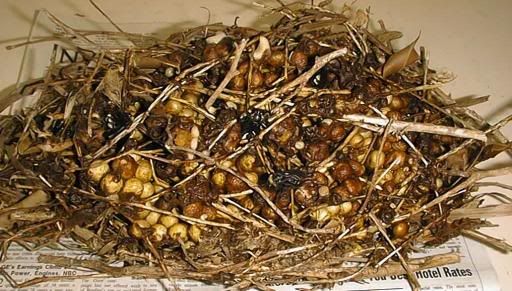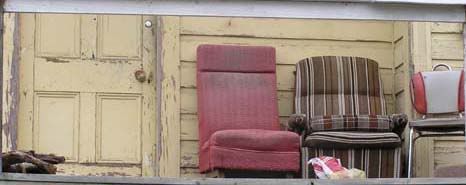Monday, October 04, 2004
Plight of a bumble bee, Part II
This post is part of a story that grew beyond control and so was serialised, if you haven't read the first part then you should do that before embarking on this post
When we left her our queen she was lying asleep under the ground waiting for the spring, as you can imagine at this stage her story gets a little monotonous so spare a thought now for the workers of the nest. With their honey stores depleted by the hibernating queens and the smorgas board of flowering plants that was the summer coming to an end they were left with no food to survive the winter. Soon after the new queens flew out from the nest for the last time the original queen died and the colony disbanded, the remnants perhaps attacked by parasitic wasps, leaving surviving workers to fend for themselves. Their instincts to collect nectar may have kept them going for a while but sooner or later a

A bumble bee nest, photo © Jim Irvin
You’ll recall when we left on that little digression the star of our story was lying under some soil sleeping the winter away. Last week the spring sun shone on her little patch of soil, producing enough heat in her hibernaculum to convince her that her long wait had finished and spring had finally sprung. It is believed that her emergence was timed to coincide with the willow tree’s first flowers, which are an important food source. If the newly emerged queen was to fulfil her purpose she would need to create a new nest from which to generate another generation of males and queens. First though she would need to eat; nectar to provide her with the energy for the search for a nest site and pollen to provide enough protein to aid the final development of her ovaries. Sadly our leading lady didn’t even get that far, emerging from her overwintering spot still a little drowsy from her long sleep and lack of sugar she made a fatal mistake: she flew into the open back door of a student flat.

The back door that lead to her doom
Unable to find any nectar she decided to leave but couldn’t find her way out and instead tried to no avail to fly through a window. Finally, sapped of energy from her frantic attempts of, and lacking nectar to replace it her body temperature plummeted and she died. With her died the prospect of a new nest, hundreds of workers to pollinate thousands of plants and a new batch of reproductives to carry her genes into another season.
The final part of this series is now online, click here to finish the story
7 Comments:
As in the case of a mule - an animal lacking a full set of chromosones should be infertile. I gather the male bumblebee must inherit the full set of queen's chromosones, in which case he would be a clone of the queen, and female.
I'm confused, could you please explain this further because I find it very interesting.
Although we usually speak of chromosomes determining the sex of their possessors it is actually the genes on those chromosomes carry that to it. As an example, in mammals the Y chromosome contains a gene we call SRY (for sex determining region of Y), the product of this gene binds to DNA during development, presumably changing which genes are being read at that stage, leading to the development of testes and “maleness.” Usually the SRY gene is on the Y chromosome so it is called a sex determining chromosome. Interestingly if the SRY gene is broken in someone with XY make-up they will develop into (an infertile) female.
Getting back on topic, it is thought that there are lots of different spots in the chromosomes of bees and their relatives that determine sex. In order for a bee to develop into a female it will need to be heterozygous (having two different versions of the gene in question) for at least one of these spots. If you remember that all males are haploid and only carry one copy of each chromosome then it stands to reason that it is impossible for them to have different genes at one spot so they will always develop into males. Most of the diploid bees the queen makes by fertilising her eggs will be heterozygous at least one spot so develop into females. A small proportion of the diploids will not be heterozygous at any of the spots and so develop into diploid males, because of the special modifications to meiosis that are required to generate haploid sperm from a haploid organism these diploid males are sterile.
The males are not clones of their mothers because they develop from an egg and each egg only contains half of their mother’s genes. This sets up the disparate situation where 100% of the male’s genes are derived from his mother while only 50% of the mother’s genes are found in the male.
Mules don’t actually lack a full set of chromosomes, their sterility is due to the chromosomes they do have not recognising each other during meiosis. During normal meiosis matching chromosomes pair up so that each gamete ends up with one complete set. A Mule has 63 chromosomes in each of its cell, 31 from the donkey and 32 from the horse. When it comes time for the different chromosomes to line during up meiosis their slightly different evolutionary histories make the different enough that the cell’s machinery doesn’t recognise the chromosomes as falling into pairs (and one ‘horse chromosome’ is left over anyway) so no gametes can be made so the mule is sterile.
Does that help at all? If not please feel free to keep asking questions
David.
I still am a little confused about bee reproduction, however, because it still seems that male bees only have 50% of the genes available to the bee species.
Are haploid (worker) bees inferior to female and male diploid bees, or do the diploid bees inherit a set of redundant genes? Also, do diploid males ever mate with the queen?
I can't shake the feeling that those bumble bees have created their own "brave new world".
Because male bees inherit one complete set of chromosomes from their mother they have the potential to inherit any gene that exists within the gene pool. The tricky bit is that some genes need to be present in the “double dose” to have an effect, male bees may carry these genes but they won’t display the associated traits. So the “extra set of genes” diploids carry aren’t quite redundant.
There are no haploid worker bees. This is the point I’ll make in the next post, but perhaps I should have made it earlier. Male bumble bees have only one purpose; they are sent out form the nest to find virgin queens with whom to mate. This is important because it means all the workers are females and as such sisters so the 75% relatedness comes in to play. Diploid males are almost indistinguishable from their haploid counterparts.
I haven’t been able to find any information about the success of diploid males in bumble bees. Apparently diploid male honey bees are killed by workers. One hopes for the sake of queens that diploid male bumble bees don’t mate, since males prevent other males from mating with queens such a mating would be the end of the queen’s chances of repouction
Again thanks for asking your questions, I hope I could help and please feel free to ask more












